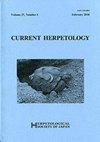三种引进的纯种鳄鱼第一代杂种的繁殖特性
IF 0.7
4区 生物学
Q4 ZOOLOGY
引用次数: 0
摘要
摘要本研究旨在探讨柬埔寨、南非和马来西亚引进的暹罗鳄(Crocodylus siamensis)、尼罗鳄(C. niloticus)和孔鳄(C. porosus)第一代杂交鳄鱼的繁殖特性。收集了3种鳄鱼杂交后代26个巢穴的789个卵和651个幼崽的数据。对杂交鳄鱼卵生殖变量的统计分析表明,除孵化率外,其他特征变量均为正态分布。采用回归分析建立了卵长、卵宽、孵化率、孵化重和卵质量之间的线性方程。结果发现,除蛋形指数外,蛋质量与其他性状均呈显著相关。鸡蛋质量和蛋形指数对孵化率有显著影响。卵数与卵特性之间没有显著的线性关系。杂交鳄鱼niloticus×C在繁殖特征变量上存在一些差异。人工饲养的暹罗和它们的亲本种(杂交种的变量通常较小)以及siamensis×C。Porosus及其亲本种(杂交种变量一般较大)。然而,在繁殖变量上,niloticus×C鳄的杂交鳄鱼没有差异。Porosus和它们的亲本种。这些结果表明,对濒危物种的杂交需要进行认真严谨的科学评估,特别是要充分考虑人为干预对杂交的影响。本文章由计算机程序翻译,如有差异,请以英文原文为准。
The Reproductive Characteristics of the First-generation Hybrid Derived from Three Introduced Purebred Crocodile Species
Abstract: The objective of the present study was to explore the reproductive characteristics of the first-generation hybrid crocodile derived from captive Crocodylus siamensis, C. niloticus and C. porosus introduced from Cambodia, South Africa, and Malaysia. The data for 789 eggs and 651 hatchlings in 26 nests of hybrids of three different crocodile species were collected. Statistical analysis of reproductive variables of hybrid crocodile eggs indicated that the characteristic variables were normally distributed except for the hatching rate. Regression analyses were used to develop the linear equation between egg length, egg width, hatching rate, hatchling weight, and egg mass. The results found a significant correlation between egg mass and other traits except for egg shape index. Significant influences of egg mass and the egg shape index on hatching rate were detected. There was no significant linear relationship between clutch size and egg characteristics. There were several differences in the reproductive characteristic variables between hybrid crocodiles of C. niloticus×C. siamensis and their parental species bred in captivity (variables of the hybrid were generally smaller) and between C. siamensis×C. porosus and their parental species (variables of the hybrid were generally larger). However, there was no difference in the reproductive variables between hybrid crocodiles of C. niloticus×C. porosus and their parental species. These results indicate that careful and rigorous scientific assessments are required on the hybridization of endangered species in particular to fully consider the effects of human intervention on hybridization.
求助全文
通过发布文献求助,成功后即可免费获取论文全文。
去求助
来源期刊

Current Herpetology
Agricultural and Biological Sciences-Animal Science and Zoology
CiteScore
1.20
自引率
14.30%
发文量
20
期刊介绍:
Current Herpetology publishes original research articles on amphibians and reptiles. It is the official journal of the Herpetological Society of Japan and is a continuation of Acta Herpetologica Japonica (1964–1971) and Japanese Journal of Herpetology (1972-1999).
 求助内容:
求助内容: 应助结果提醒方式:
应助结果提醒方式:


